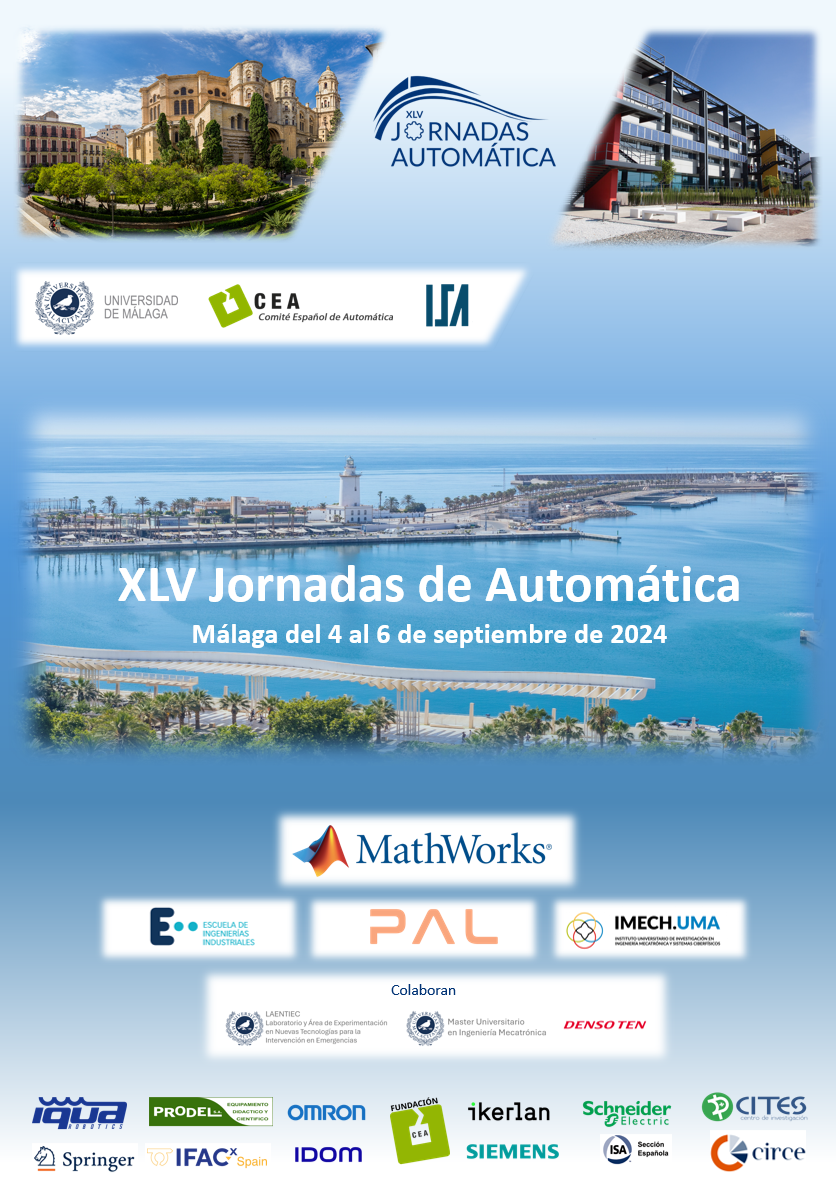Singularidades en robots paralelos:
Detección y evasión en tiempo real
DOI:
https://doi.org/10.17979/ja-cea.2024.45.10792Palabras clave:
Robots manipuladores, Detección de singularidades, Algoritmos en tiempo real, Sistemas de control de movimiento, Tecnología de asistencia e ingeniería de rehabilitación, Diseño de ExperimentosResumen
Gracias a su precisión y su gran capacidad de carga, en la actualidad el uso de robots paralelos en aplicaciones de interacción humano-robot es habitual. No obstante, en su espacio de trabajo pueden aparecer configuraciones problemáticas (singularidades Tipo II) donde se pierde el control del robot, comprometiendo la seguridad y limitando las técnicas de control aplicables. En este artículo, se establecen criterios clave para la detección y evasión de singularidades Tipo II en tiempo real. De la misma forma, se presenta la implementación de un algoritmo de evasión de singularidades Tipo II con un control de fuerza-posición en un robot paralelo de 4 grados de libertad para rehabilitación de rodilla. El algoritmo de evasión detecta las singularidades Tipo II midiendo la posición del efector final e identificando los actuadores responsables de la singularidad. Los resultados obtenidos verifican la efectividad de los puntos clave propuestos en el desarrollo aplicaciones de interacción humano-robot en tiempo real para rehabilitación física con robots paralelos.
Referencias
Agarwal, A., Nasa, C., Bandyopadhyay, S., 2 2016. Dynamic singularity avoidance for parallel manipulators using a task-priority based control scheme. Mechanism and Machine Theory 96, 107–126. DOI: 10.1016/j.mechmachtheory.2015.07.013
Arakelian, V., Briot, S., Glazunov, V., 9 2008. Increase of singularity-free zones in the workspace of parallel manipulators using mechanisms of variable structure. Mechanism and Machine Theory 43, 1129–1140. DOI: 10.1016/j.mechmachtheory.2007.09.005
Briot, S., Khalil, W., 2015. Dynamics of Parallel Robots, 1st Edition. Vol. 35. Springer International Publishing. DOI: 10.1007/978-3-319-19788-3
Ceccarelli, M., 2022. Fundamentals of Mechanics of Robotic Manipulation. Springer International Publishing 112, 1–381. DOI: 10.1007/978-3-030-90848-5
Dash, A. K., Chen, I.-M., Yeo, S. H., Yang, G., 7 2005.Workspace generation and planning singularity-free path for parallel manipulators. Mechanism and Machine Theory 40, 776–805. DOI: 10.1016/j.mechmachtheory.2005.01.001
Dong, M., Fan, W., Li, J., Zhou, X., Rong, X., Kong, Y., Zhou, Y., 6 2021. A New Ankle Robotic System Enabling Whole-Stage Compliance Rehabilitation Training. IEEE/ASME Transactions on Mechatronics 26, 1490–1500. DOI: 10.1109/TMECH.2020.3022165
Gosselin, C., Angeles, J., jun 1990. Singularity analysis of closed-loop kinematic chains. IEEE Transactions on mRobotics and Automation 6 (3), 281–290. DOI: 10.1109/70.56660
Hubert, J., Merlet, J.-P., 2 2009. Static of Parallel Manipulators and Closeness to Singularity. Journal of Mechanisms and Robotics 1, 1–6. DOI: 10.1115/1.2961335
Pulloquinga, J. L., 5 2023. A new index for detecting and avoiding type ii singularities for the control of non-redundant parallel robots. Ph.D. thesis, Universitat Polit`ecnica de Val`encia. DOI: 10.4995/THESIS/10251/194271
Pulloquinga, J. L., Mata, V., Valera, A´ ., Zamora-Ortiz, P., D´ıaz-Rodr´ıguez, M., Zambrano, I., 4 2021. Experimental analysis of Type II singularities and assembly change points in a 3UPS+RPU parallel robot. Mechanism and Machine Theory 158. DOI: 10.1016/j.mechmachtheory.2020.104242
Rastegarpanah, A., Saadat, M., Borboni, A., 2016. Parallel Robot for Lower Limb Rehabilitation Exercises. Applied Bionics and Biomechanics 2016, 1–10. DOI: 10.1155/2016/8584735
Schumacher, M., Wojtusch, J., Beckerle, P., von Stryk, O., 9 2019. An introductory review of active compliant control. Robotics and Autonomous Systems 119, 185–200. DOI: 10.1016/j.robot.2019.06.009
Valero, F., D´ıaz-Rodr´ıguez, M., Valle´s, M., Besa, A., Bernabe´u, E., Ángel Valera, 8 2020. Reconfiguration of a parallel kinematic manipulator with 2T2R motions for avoiding singularities through minimizing actuator forces. Mechatronics 69, 102382. DOI: 10.1016/j.mechatronics.2020.102382
Voglewede, P., Ebert-Uphoff, I., 12 2005. Overarching framework for measuring closeness to singularities of parallel manipulators. IEEE Transactions on Robotics 21, 1037–1045. DOI: 10.1109/TRO.2005.855993
Wu, J., Chen, X., Li, T., Wang, L., 2 2013. Optimal design of a 2-DOF parallel manipulator with actuation redundancy considering kinematics and natural frequency. Robotics and Computer-Integrated Manufacturing 29, 80–85. DOI: 10.1016/j.rcim.2012.07.005
Zhou, J., Li, Z., Li, X., Wang, X., Song, R., 12 2021. Human–Robot Cooperation Control Based on Trajectory Deformation Algorithm for a Lower Limb Rehabilitation Robot. IEEE/ASME Transactions on Mechatronics 26, 3128–3138. DOI: 10.1109/TMECH.2021.3053562
Descargas
Publicado
Número
Sección
Licencia
Derechos de autor 2024 José Luis Pulloquinga Zapata, V. Mata, M. Valles, A. Valera

Esta obra está bajo una licencia internacional Creative Commons Atribución-NoComercial-CompartirIgual 4.0.





